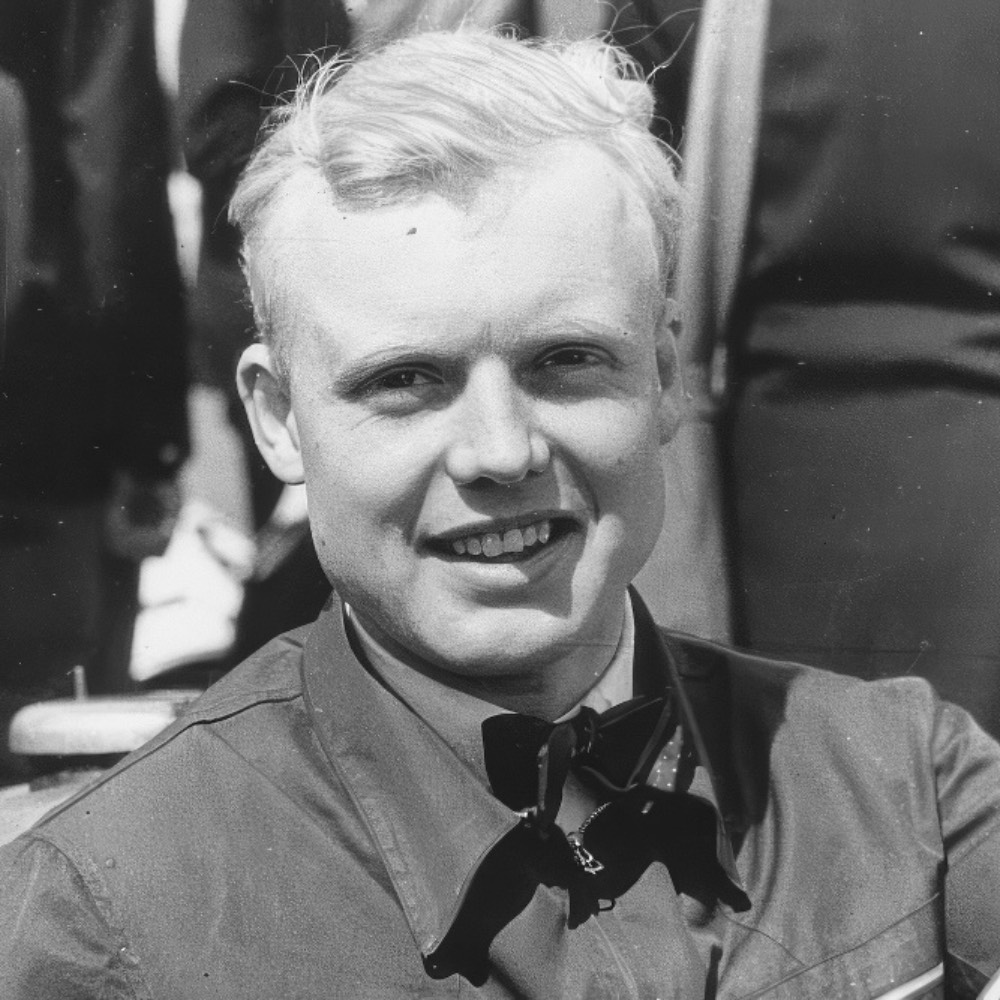
Mike Hawthorn
World Championships
1958
Career Statistics
Biography
John Michael Hawthorn (10 April 1929 - 22 January 1959) was a British racing driver who competed in Formula One from 1952 to 1958, remembered as Britain's first Formula One World Champion whose 1958 title victory was overshadowed by tragedy and whose own life ended just three months after retirement in a road accident that remains shrouded in mystery. Born in Mexborough, Yorkshire, England, Hawthorn grew up in a motorsport-oriented family—his father Leslie was a racing enthusiast who purchased the Tourist Trophy Garage near the legendary Brooklands circuit in Farnham, Surrey, ensuring young Mike was immersed in racing culture from childhood. Tall, blond, and rakishly handsome with a trademark bow tie, Hawthorn embodied the "gentleman racer" archetype of 1950s motorsport, equally comfortable on the racetrack as in the pub afterward.
Hawthorn began competing in his father's modified Riley before progressing to more competitive machinery, earning his Formula One debut at the 1952 Belgian Grand Prix. His breakthrough came at the 1953 French Grand Prix at Reims, where the 24-year-old Hawthorn dueled with the great Juan Manuel Fangio in an epic battle that saw both drivers break the lap record multiple times before Hawthorn claimed victory by one second—defeating a four-time World Champion in only his seventh Grand Prix established Hawthorn as a star. Enzo Ferrari immediately signed him for 1953-1954, making Hawthorn one of the first British drivers to join the Scuderia, though his Ferrari years brought mixed results due to unreliable cars and Hawthorn's ongoing kidney problems that would plague him throughout his career.
After stints with Vanwall and BRM brought little success, Hawthorn rejoined Ferrari for 1957 alongside Luigi Musso, Eugenio Castellotti, and Peter Collins—forming one of Ferrari's strongest driver lineups. The 1958 season would prove to be both Hawthorn's greatest triumph and his deepest tragedy. Driving the Ferrari Dino 246, Hawthorn won only one race all season—the French Grand Prix at Reims, the same circuit where he had claimed his maiden victory five years earlier—yet his consistency across the season kept him in championship contention. His primary title rival was Vanwall's Stirling Moss, the supremely talented British driver who won four races to Hawthorn's one but suffered from worse reliability.
The season was marked by devastating losses: Hawthorn's Ferrari teammate and close friend Luigi Musso was killed in a crash at the French Grand Prix, and then Peter Collins—Hawthorn's best friend and another teammate—died in a horrific accident at the German Grand Prix at the Nürburgring when his Ferrari Dino 246 left the track at Pflanzgarten and somersaulted through the air, throwing Collins from the car and killing him instantly. Hawthorn witnessed the crash and was devastated by the loss of his closest friend, suffering deep emotional trauma that left him questioning whether he could continue racing. Despite his grief, Hawthorn pressed on to the season finale in Morocco, arriving tied on points with Moss.
In an ironic twist, Moss sportingly testified on Hawthorn's behalf after the British driver was threatened with disqualification for reversing on track, potentially saving Hawthorn's championship. Hawthorn finished second in Morocco (to Moss) to claim the 1958 World Drivers' Championship by a single point—becoming Britain's first Formula One World Champion despite winning only one race to Moss's four. This made Hawthorn the first driver to win the championship with just a single victory, a record he shares with Keke Rosberg (1982) as the fewest wins by a World Champion under any formula. Devastated by the deaths of Collins and Musso, disillusioned with racing, and suffering from ongoing kidney problems, Hawthorn announced his immediate retirement from motorsport at age 29, just days after winning the championship.
He planned to focus on managing his father's garage business and live a quieter life away from the dangers of racing. Tragically, Hawthorn's retirement lasted only three months. On 22 January 1959, while driving his modified 1958 Jaguar 3.4-litre saloon on the A3 Guildford bypass near Onslow Village in wet conditions, Hawthorn's car skidded off the road and struck a tree. The 29-year-old World Champion was killed instantly.
The circumstances surrounding the accident have never been fully explained—Hawthorn was an experienced driver familiar with the road, and some evidence suggested he may have suffered a medical blackout, possibly related to his chronic kidney problems, that caused him to lose control. Other theories suggested he was racing with his friend Rob Walker, though this was never proven. An inquest recorded a verdict of accidental death, but the exact cause remains uncertain. Mike Hawthorn's death, coming so soon after his championship victory and retirement, shocked Britain and the motorsport world.
The cruel irony that he had survived the dangers of 1950s Formula One racing—one of the sport's deadliest eras—only to die in a road accident just months after quitting the sport was not lost on anyone. In recognition of his legacy, the RAC established the Hawthorn Memorial Trophy in 1959, awarded annually to the most successful British or Commonwealth driver in Formula One—an honor that has been won by legends including Stirling Moss, Jackie Stewart, Nigel Mansell, and Lewis Hamilton. Mike Hawthorn competed in 45 Formula One Grands Prix, winning three races, achieving 18 podiums, and scoring four pole positions. His 1958 World Championship remains one of the sport's most controversial titles due to winning with just one victory, yet also one of its most poignant, overshadowed by the deaths of two teammates and followed by Hawthorn's own death just weeks later.
He is remembered as Britain's first Formula One World Champion, a supremely talented driver whose smooth style and natural speed were evident to all who watched him, a gentleman racer from motorsport's most romantic and dangerous era, and a tragic figure whose championship year cost him his friends and, ultimately, his own life.